Research on Online Destination Image of Zhenjiang Section of the Grand Canal Based on Network Content Analysis
Abstract
1. Introduction
2. Literature Review
2.1. Online Destination Image and DMO
2.2. Cultural Heritage Tourism
- (1)
- Uniqueness: Ekinci and Hosany assert that the personality characteristics of the destination are directly related to the attraction of the destination because they can identify and measure the personality of the destination [31]. The uniqueness of heritage will also have a positive impact on tourists’ experience, enhance the visiting intention of potential tourists and enhance regional competitiveness [32]. Ginting claims that landmark, which is part of the uniqueness of heritage tourism, plays a key role in enhancing the city identity to make it more attractive and recognizable [33].
- (2)
- Familiarity: Shubert’s research shows that the more familiar the cultural heritage elements of a single destination are, the more positive its evaluation of tourism attraction is [27]. This relationship has been confirmed in many years of scientific research [34,35,36,37]. In addition, familiarity will also increase the details of the visual memory of the place [38]. Therefore, establishing an attractive image of a previously unknown scenic spot is a great challenge because potential tourists tend to underestimate it [39].
- (3)
- Communication mode: The communication mode of heritage is very important for potential tourists who are interested in more specific matters in specific areas [40]. An attractive and functional heritage display is very important for successful media coverage. In this respect, information design is of great importance in explaining, displaying and spreading heritage. It urges tourists to pay more attention to the exclusivity and unique heritage of a place [40].
3. Materials and Methods
3.1. Research Object
3.2. Data Collection
- (1)
- Collection and screening of samples. All the data in this article were obtained using a web-text mining tool developed by Python. Samples were all from articles published by WOAs. Researchers adopted the top 200 articles containing the keywords “Zhenjiang section of the Grand Canal” in WOA because the similarity increased and the correlation decreased extremely after these 200 articles. The collected data contained article title, article content, publishing time and name of WOA. This paper strictly limited the source of articles and number of words, excluding articles from educational institutions, photographers’ associations, personal media platforms and short articles with less than 200 words. In addition, every article content had been manually screened many times, and the articles that did not meet the research purpose, such as photography exhibition, activity report, social news, conference, speech and online voting, were excluded. After manual screening of repetitive, irrelevant and too-short content, a total of 119,618 words were obtained. WOAs mainly included those operated by local government agencies, such as Zhenjiang Style, Danyang Daily, Zhenjiang Release and others operated by commercial institutions related to canal, such as Canal Network (as shown in Table 1).
- (2)
- Data cleaning. The researchers and several relevant experts of ZGC used the triangular mutual evidence method to compile the user-defined dictionary jointly. This study used jieba word segmentation software to segment Chinese sentences and remove specific characters, such as stop words, spaces, line breaks and punctuation. Several coders filtered out meaningless words and merged synonyms at the same time. The corresponding operation would not be carried out unless they reached an agreement on inclusion/exclusion. This method effectively reduces the wrong word segmentation. It is necessary to check and improve the segmentation results many times until a satisfactory result is obtained, specifically including filtering out meaningless words, merging synonyms and supplementing the custom dictionary to ensure the correctness and comprehensiveness of the proper nouns and improve the reliability of similarity calculation.
3.3. Text Analysis
4. Results
4.1. High Frequency Word Analysis
4.2. Theme Classification of the Projected Image
4.3. Social Network Analysis of Cognitive-Emotional Image
4.4. Spatio-Temporal Analysis of the Cultural Heritage
4.4.1. Temporal Analysis of Cultural Heritage
- (1)
- The river course of Qin Dynasty, specifically the Dantu Channel dug by Qin Shi Huang in 210 BC, which connected with the canal dug by Fu Chai, the king of Wu, was the embryonic form of Jiangnan Canal.
- (2)
- Lian Lake, which was founded in the Western Jin Dynasty, was the most important economic transportation project of Jiangnan Canal. After more than 1600 years, Lian Lake had played an important role in the regulation, storage and irrigation of the western Tai Lake basin.
- (3)
- The most influential historical and cultural district of the Tang Dynasty was Xijin Ferry. Xijin Ferry, located in the west of Zhenjiang, was formed in the Three Kingdoms period and had a complete ferry function in the Tang Dynasty. There are many historical and cultural relics and groups of traditional residential houses since the Tang Dynasty. It is the oldest, largest and best-preserved old ferry and historical district, and is known as “China Old Ferry Museum”.
- (4)
- Various heritage forms closely related to the canal in the Song Dynasty were mature, among which Jingkou Sluice, Granary in the Song and Yuan Dynasties and so on are most prominent.
- (5)
- Kaitai Bridge is the most famous bridge in the Ming Dynasty. It is the largest and most well-preserved ancient stone arch bridge in Danyang.
- (6)
- Jianbi Sluice is the most representative of modern sluice, which was originally a control gate to divert water from the Yangtze River for irrigation in the west of the lake. In the early 1980s, it became the new entrance gate of Jiangnan Canal, from which ships coming up from North Jiangsu Canal and Yangtze River entered Jiangnan Canal.
4.4.2. Spatial Analysis of Cultural Heritage
5. Discussion and Conclusions
5.1. The Theme of the Projected Image
5.2. Analysis of Cognitive, Emotional and Overall Image of the ZGC
5.3. Nostalgic Characteristics of Brand Image of the ZGC
5.4. Aanalysis and Protection Strategy of Cultural Heritage
6. Strengths and Limitations
7. Future Research Directions
- (1)
- The effectiveness of destination marketing can be measured by studying the gap or consistency between the projected image and perceived image [14]. Therefore, achieving consistency in destination images is a key goal of destination promoters and marketers, who then intend to assess whether their projected destination images have been conveyed and absorbed by tourists [63,64]. Future research can focus on whether there is any deviation between the government’s cultural value transmission and the cultural connotation received by tourists before and after travel. The government and urban designers can use these results to reshape or improve the external image of the ZGC according to the deviation of tourists’ perceptions.
- (2)
- At present, many emerging media industries have expanded the access to network content. In recent years, many studies have tried to analyze travel photos. Their visual representation of heritage tourism destinations and the analysis of these photos may provide DMO with unique insights [65,66]. In China, short videos are very popular, and the emergence of these videos also provides a great deal of text content for the tourism industry, which can basically represent the current situation of cultural heritage communication [67].
- (3)
- The projection image of DMO can be used to refine the theme of the tourism route to meet the personalized needs of tourists. Tourism route planning is carried out under the appropriate heritage interpretation strategy. As a working method, it can promote the understanding and social utilization of heritage sites along the route [68]. Network content can provide valuable insights for potential tourists and help them optimize their destination selection and explore their travel routes or improve their services for tourism practitioners. In the future, different tourism routes can be provided for potential tourists according to the types of cultural heritage and tourists’ motivation and preference.
- (4)
- A model using SEM needs to be established to discuss the relationships among the variables. Some previous studies have analyzed the impact of the network content generated by DMO on the destination image [17,69]. There is no research to discuss the impact of the marketing communication of DMO on the online destination image, tourists’ visit intention and revisit from the perspective of a canal heritage site. Based on this research, we can try to explain the impact of the online platform of DMO on the attraction of cultural heritage from the aspects of nostalgia, psychological distance and emotional image.
Author Contributions
Funding
Institutional Review Board Statement
Informed Consent Statement
Data Availability Statement
Acknowledgments
Conflicts of Interest
References
- Ding, F.; Ma, T. Dynamic relationship between tourism and homogeneity of tourist destinations. IEEE Access 2018, 6, 51470–51476. [Google Scholar] [CrossRef]
- Vinyals-Mirabent, S. European urban destinations’ attractors at the frontier between competitiveness and a unique destination image. A benchmark study of communication practices. J. Destin. Mark. Manag. 2019, 12, 37–45. [Google Scholar] [CrossRef]
- Kaplan, A.M.; Haenlein, M. Users of the world, unite! The challenges and opportunities of social media. Bus. Horiz. 2010, 53, 59–68. [Google Scholar] [CrossRef]
- Hunter, W.C. The social construction of tourism online destination image: A comparative semiotic analysis of the visual representation of Seoul. Tour. Manag. 2016, 54, 221–229. [Google Scholar] [CrossRef]
- Arasli, H.; Abdullahi, M.; Gunay, T. Social Media as a Destination Marketing Tool for a Sustainable Heritage Festival in Nigeria: A Moderated Mediation Study. Sustainability 2021, 13, 6191. [Google Scholar] [CrossRef]
- Mak, A.H.N. Online destination image: Comparing national tourism organisation’s and tourists’ perspectives. Tour. Manag. 2017, 60, 280–297. [Google Scholar] [CrossRef]
- Cakmak, E.; Isaac, R.K. What destination marketers can learn from their visitors’ blogs: An image analysis of Bethlehem, Palestine. J. Destin. Mark. Manag. 2012, 1, 124–133. [Google Scholar] [CrossRef]
- Gabbioneta, C.; De Carlo, M. The role of news articles, prior destination experience, and news involvement in destination image formation. Int. J. Tour. Res. 2019, 21, 291–301. [Google Scholar] [CrossRef]
- Nassar, M.A.; Mostafa, M.M.; Reisinger, Y. Factors influencing travel to Islamic destinations: An empirical analysis of Kuwaiti nationals. Int. J. Cult. Tour. Hosp. Res 2015, 9, 36–53. [Google Scholar] [CrossRef]
- Jalilvand, M.R.; Samiei, N.; Dini, B.; Manzari, P.Y. Examining the structural relationships of electronic word of mouth, destination image, tourist attitude toward destination and travel intention: An integrated approach. J. Destin. Mark. Manag. 2012, 1, 134–143. [Google Scholar] [CrossRef]
- World Tourism Organization. UNWTO Tourism Highlights; UNWTO: Madrid, Spain, 2014. [Google Scholar]
- Koeltringer, C.; Dickinger, A. Analyzing destination branding and image from online sources: A web content mining approach. J. Bus. Res. 2015, 68, 1836–1843. [Google Scholar] [CrossRef]
- Timur, S.; Getz, D. A network perspective on managing stakeholders for sustainable urban tourism. Int. J. Contemp. Hosp. Manag. 2008, 20, 445–461. [Google Scholar] [CrossRef]
- He, Z.; Deng, N.; Li, X.; Gu, H. How to “Read” a Destination from Images? Machine Learning and Network Methods for DMOs’ Image Projection and Photo Evaluation. J. Travel Res. 2021, 61, 597–619. [Google Scholar] [CrossRef]
- Shi, K.; Zhang, Y.; Liu, Y. Study on Tourists’ Perception of the Grand Canal Cultural Heritage Based on Network Travels. In Proceedings of the 2019 IEEE Fifth International Conference on Big Data Computing Service and Applications (BigDataService), San Francisco, CA, USA, 4–9 April 2019; pp. 79–82. [Google Scholar] [CrossRef]
- Liang, X.; Xue, J. Online Destination Image Generated by National Tourism Organizations Hosed WeChat Official Accounts. In Proceedings of the 2021 7th International Conference on Information Management (ICIM), Imperial Coll London, S Kensington Campus, London, UK, 27–29 March 2021; pp. 140–143. [Google Scholar] [CrossRef]
- Molinillo, S.; Liébana-Cabanillas, F.; Anaya-Sánchez, R.; Buhalis, D. DMO online platforms: Image and intention to visit. Tour. Manag. 2018, 65, 116–130. [Google Scholar] [CrossRef]
- Govers, R.; Go, F.M. Projected destination image online: Website content analysis of pictures and text. Inf. Technol. Tour. 2005, 7, 73–89. [Google Scholar] [CrossRef]
- Choi, S.; Lehto, X.Y.; Morrison, A.M. Destination image representation on the web: Content analysis of Macau travel related websites. Tour. Manag. 2007, 28, 118–129. [Google Scholar] [CrossRef]
- Zhou, L. Online rural destination images: Tourism and rurality. J. Destin. Mark. Manag. 2014, 3, 227–240. [Google Scholar] [CrossRef]
- Konwencja UNESCO w Sprawie Ochrony światowego Dziedzictwa Kulturalnego i Naturalnego. 1972. Available online: https://www.unesco.pl/fileadmin/user_upload/pdf/Konwencja_o_ochronie_swiatowego_dziedzictwa.pdf (accessed on 25 August 2021).
- Henderson, J.C. Conserving colonial heritage: Raffles hotel in Singapore. Int. J. Herit. Stud. 2001, 7, 7–24. [Google Scholar] [CrossRef]
- Tang, L.; Jang, S. The Evolution from Transportation to Tourism: The Case of the New York Canal System. Tour. Geogr. 2010, 12, 435–459. [Google Scholar] [CrossRef]
- Guttormsen, T.S.; Fageraas, K. The social production of ‘attractive authenticity’ at the World Heritage Site of Røros, Norway. Int. J. Herit. Stud. 2011, 17, 442–462. [Google Scholar] [CrossRef]
- Canale, R.R.; de Simone, E.; di Maio, A.; Parenti, B. UNESCO World Heritage sites and tourism attractiveness: The case of Italian provinces. Land Use Policy 2019, 85, 114–120. [Google Scholar] [CrossRef]
- Castillo-Manzano, J.I.; Castro-Nuño, M.; Lopez-Valpuesta, L.; Zarzoso, Á. Assessing the tourism attractiveness of World Heritage Sites: The case of Spain. J. Cult. Herit. 2021, 48, 305–311. [Google Scholar] [CrossRef]
- Szubert, M.; Warcholik, W.; Żemła, M. The Influence of Elements of Cultural Heritage on the Image of Destinations, Using Four Polish Cities as an Example. Land 2021, 10, 671. [Google Scholar] [CrossRef]
- Beerli, A.; Martín, J.D. Factors influencing destination image. Ann. Tour. Res. 2004, 31, 657–681. [Google Scholar] [CrossRef]
- Wang, R.; Hao, J. Gender Difference on Destination Image and Travel Options: An Exploratory Text-Mining Study. In Proceedings of the 2018 15th International Conference on Service Systems and Service Management (ICSSSM), Hangzhou, China, 21–22 July 2018. [Google Scholar] [CrossRef]
- Ceylan, D.; Izel, B.; Karaka, H. Destination image perception patterns of tourist typologies. Int. J. Tour. Res. 2020, 23, 401–416. [Google Scholar] [CrossRef]
- Ekinci, Y.; Hosany, S. Destination Personality: An Application of Brand Personality to Tourism Destinations. J. Travel Res. 2006, 45, 127–139. [Google Scholar] [CrossRef]
- Huete-Alcocer, N.; Martinez-Ruiz, M.P.; López-Ruiz, V.R.; Izquiedo-Yusta, A. Archeological Tourist Destination Image Formation: Influence of Information Sources on the Cognitive, Affective and Unique Image. Front. Psychol. 2019, 10, 2382. [Google Scholar] [CrossRef] [PubMed]
- Ginting, N.; Rahman, N.V.; Nasution, A.D. A Comparative Study of Landmark on Heritage Tourism in Sumatra. Environ. Behav. Proc. J. 2020, 5, 221–227. [Google Scholar] [CrossRef]
- Prebensen, N.K. Exploring tourists’ images of a distant destination. Tour. Manag. 2007, 28, 747–756. [Google Scholar] [CrossRef]
- Stylidis, D.; Woosnam, K.M.; Ivkov, M.; Kim, S.S. Destination loyalty explained through place attachment, destination familiarity and destination image. Int. J. Tour. Res. 2020, 22, 604–616. [Google Scholar] [CrossRef]
- Kim, S.; Lehto, X.; Kandampully, J. The role of familiarity in consumer destination image formation. Tour. Rev. 2019, 74, 885–901. [Google Scholar] [CrossRef]
- Milman, A.; Pizam, A. The role of awareness and familiarity with a destination: The central Florida case. J. Travel Res. 1995, 33, 21–27. [Google Scholar] [CrossRef]
- Walmsley, D.J.; Jenkins, J.M. Tourism cognitive mapping of unfamiliar environments. Ann. Tour. Res. 1992, 19, 268–286. [Google Scholar] [CrossRef]
- Ryan, C.; Cave, J. Structuring destination image: A qualitative approach. J. Travel Res. 2005, 44, 143–150. [Google Scholar] [CrossRef]
- Santos, C.; Neto, M.J.P.; Neves, M. Information Design in Presentation, Interpretation and Dissemination of Natural and Cultural Heritage. In Proceedings of the 2019 10th International Conference on Applied Human Factors and Ergonomics, Washington, DC, USA, 24–28 July 2019; pp. 413–423. [Google Scholar] [CrossRef]
- Baloglu, S.; McCleary, K.W. A model of destination image formation. Ann. Tour. Res. 1999, 26, 868–897. [Google Scholar] [CrossRef]
- Deng, N.; Li, X.R. Feeling a Destination through the “Right” Photos: A Machine Learning Model for DMOs’ Photo Selection. Tour. Manag. 2018, 65, 267–278. [Google Scholar] [CrossRef]
- Guimerà, R. “Networks” is Different; Oxford University Press: New York, NY, USA, 2012. [Google Scholar] [CrossRef]
- Król, K. Assessment of the Cultural Heritage Potential in Poland. Sustainability 2021, 13, 6637. [Google Scholar] [CrossRef]
- Trope, Y.; Liberman, N. Construal-level theory of psychological distance. Psychol. Rev. 2010, 117, 440–463. [Google Scholar] [CrossRef]
- Massara, F.; Severino, F. Psychological distance in the heritage experience. Ann. Tour. Res. 2013, 42, 108–129. [Google Scholar] [CrossRef]
- Tsai, T.C.; Wang, Y.C. Experiential value in branding food tourism. J. Destin. Mark. Manag. 2016, 6, 56–65. [Google Scholar] [CrossRef]
- Lai, M.Y.; Khoo-Lattimore, C.; Wang, Y. A perception gap investigation into food and cuisine image attributes for destination branding from the host perspective: The case of Australia. Tour. Manag. 2018, 69, 579–595. [Google Scholar] [CrossRef]
- Lalicic, L.; Huertas, A.; Moreno, A.; Jabreel, M. Which emotional brand values do my followers want to hear about? An investigation of popular European tourist destinations. Inf. Technol. Tour. 2018, 21, 63–81. [Google Scholar] [CrossRef]
- Tiago, F.; Correia, P.; Briciu, V.A.; Borges-Tiago, T. Geotourism Destinations Online Branding Co-Creation. Sustainability 2021, 13, 8874. [Google Scholar] [CrossRef]
- Goh, E. Understanding the heritage tourist market segment. Int. J. Leis. Tour. Mark. 2010, 1, 257–270. [Google Scholar] [CrossRef]
- Nawas, M.P.; Platt, J.J. A future-oriented theory of nostalgia. J. Individ. Psychol. 1965, 21, 51–57. [Google Scholar]
- Verma, A.; Rajendran, G. The effect of historical nostalgia on tourists’ destination loyalty intention: An empirical study of the world cultural heritage site—Mahabalipuram, India. Asia Pac. J. Tour. Res. 2017, 22, 977–990. [Google Scholar] [CrossRef]
- Chen, W.; Zhang, M.; Pan, Z.; Liu, G.; Shen, H.; Chen, S.; Liu, Y. Animations, Games, and Virtual Reality for the Jing-Hang Grand Canal. Comput. Graph. Appl. 2010, 30, 84–88. [Google Scholar] [CrossRef]
- Du, X.; Guo, H.; Fan, X.; Tan, J.; Zhu, J. Study on 3D visualization application for the Grand Canal heritage site research. In Proceedings of the 6th International Symposium on Digital Earth: Data Processing and Applications, Beijing, China, 9–12 September 2009; Volume 7841. [Google Scholar] [CrossRef]
- Youn, S.H.; Uzzell, D. The young generations’ conceptualisation of cultural tourism: Colonial heritage attractions in South Korea. Asia Pac. J. Tour. Res. 2016, 21, 1324–1342. [Google Scholar] [CrossRef]
- Slavec, A.; Sajinčič, N.; Starman, V. Use of Smartphone Cameras and Other Applications While Traveling to Sustain Outdoor Cultural Heritage. Sustainability 2021, 13, 7312. [Google Scholar] [CrossRef]
- Wan, C.K.B.; Chow, K.K.N.; Bont, C.J.P.M.; Hekkert, P. Finding synergy between oral and visual narratives on memorable and meaningful tourism experiences. Inf. Technol. Tour. 2020, 22, 107–130. [Google Scholar] [CrossRef]
- Liu, B. Web Data Mining; Springer: New York, NY, USA, 2011. [Google Scholar] [CrossRef]
- Echtner, C.M.; Ritchie, J.R.B. The measurement of destination image: An empirical assessment. J. Travel Res. 1993, 31, 3–13. [Google Scholar] [CrossRef]
- Ritchie, J.B.; Crouch, G.I. The Competitive Destination: A sustainable tourism perspective; CABI: Wallingford, UK, 2003. [Google Scholar] [CrossRef]
- Toral, S.L.; Martínez-Torres, M.R.; Gonzalez-Rodriguez, M.R. Identification of the Unique Attributes of Tourist Destinations from Online Reviews. J. Travel Res. 2017, 57, 908–919. [Google Scholar] [CrossRef]
- Ji, S.; Wall, G. Understanding supply- and demand-side destination image relationships: The case of Qingdao, China. J. Vacat. Mark. 2015, 21, 205–222. [Google Scholar] [CrossRef]
- Marine-Roig, E.; Ferrer-Rosell, B. Measuring the gap between projected and perceived destination images of Catalonia using compositional analysis. Tour. Manag. 2018, 68, 236–249. [Google Scholar] [CrossRef]
- McMullen, M. “Pinning” tourist photographs: Analyzing the photographs shared on Pinterest of heritage tourist destinations. Curr. Issues Tour. 2019, 23, 376–387. [Google Scholar] [CrossRef]
- López-Chao, V.; Lopez-Pena, V. Aesthetical Appeal and Dissemination of Architectural Heritage Photographs in Instagram. Buildings 2020, 10, 225. [Google Scholar] [CrossRef]
- Li, Y.; Xu, X.; Song, B.; He, H. Impact of Short Food Videos on the Tourist Destination Image—Take Chengdu as an Example. Sustainability 2020, 12, 6739. [Google Scholar] [CrossRef]
- Leanza, P.M.; Porto, S.M.C.; Sapienza, V.; Cascone, S.M. A heritage interpretation-based itinerary to enhance tourist use of traditional rural buildings. Sustainability 2016, 8, 47. [Google Scholar] [CrossRef]
- Sultan, M.T.; Sharmin, F.; Badulescu, A.; Gavrilut, D.; Xue, K. Social Media-Based Content towards Image Formation: A New Approach to the Selection of Sustainable Destinations. Sustainability 2021, 13, 4241. [Google Scholar] [CrossRef]
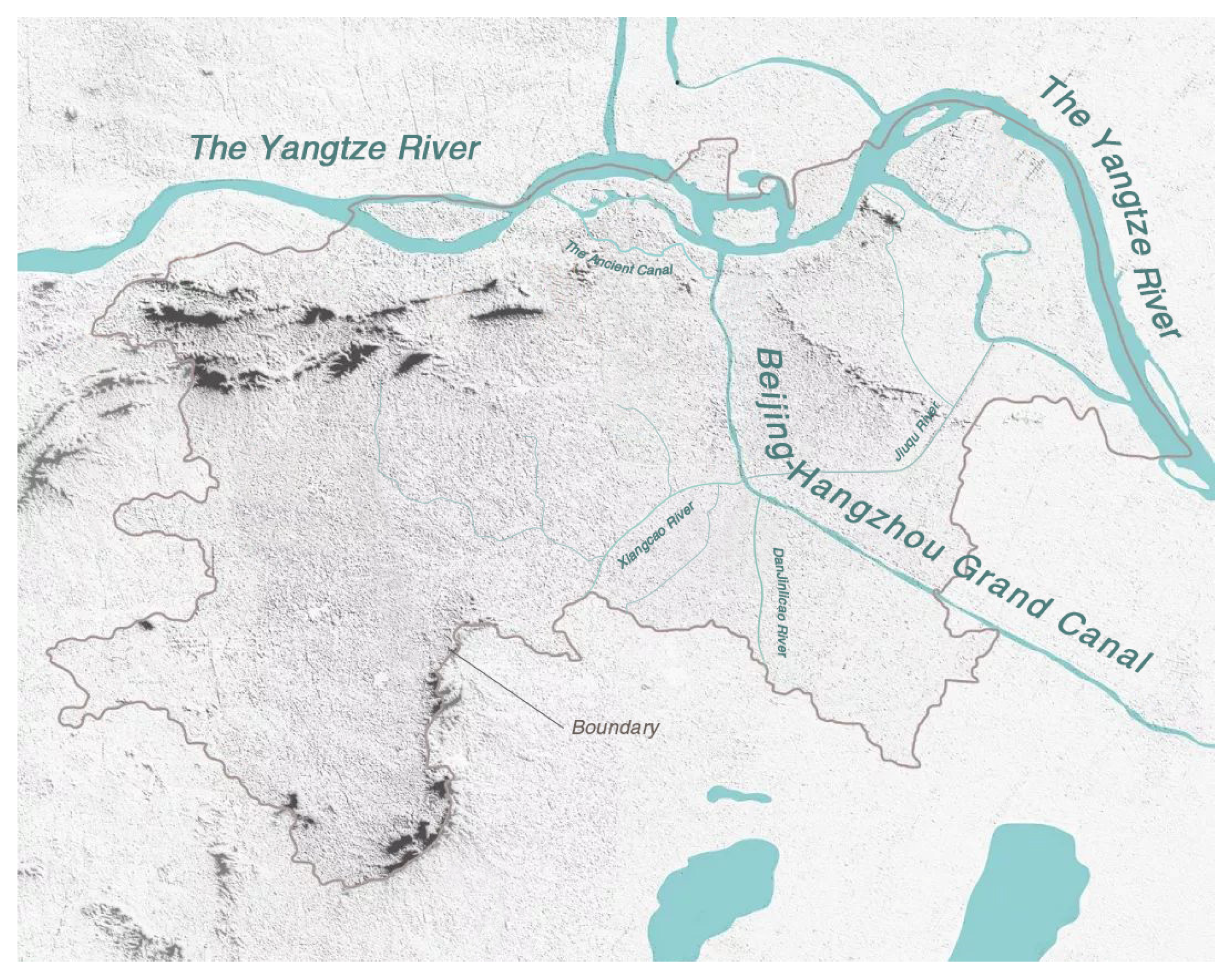

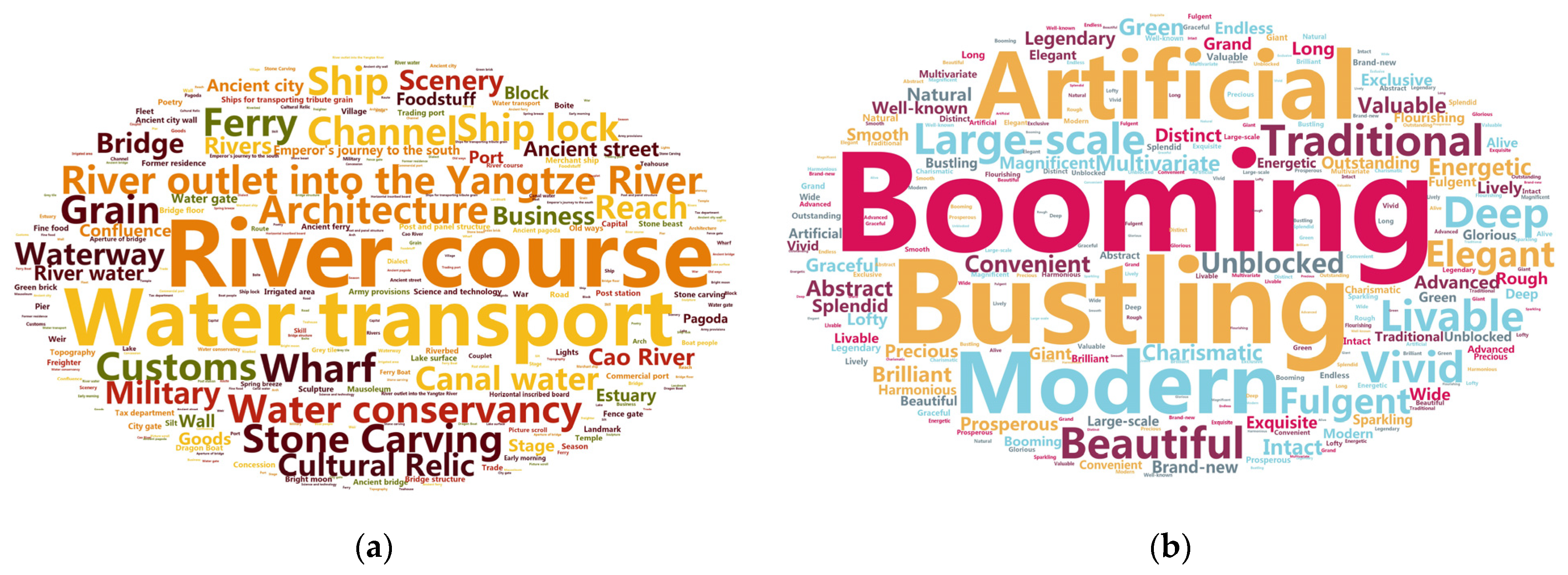
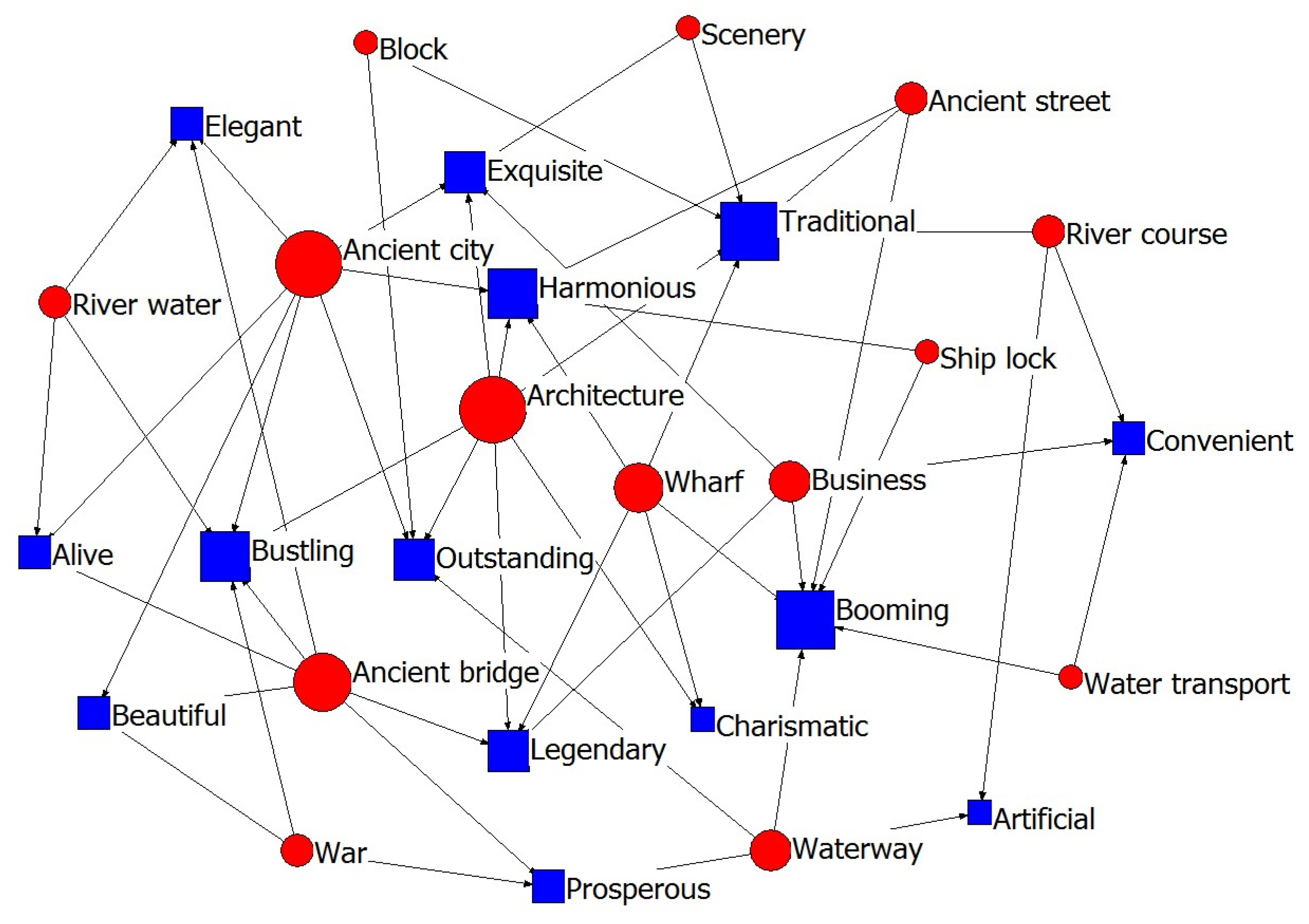
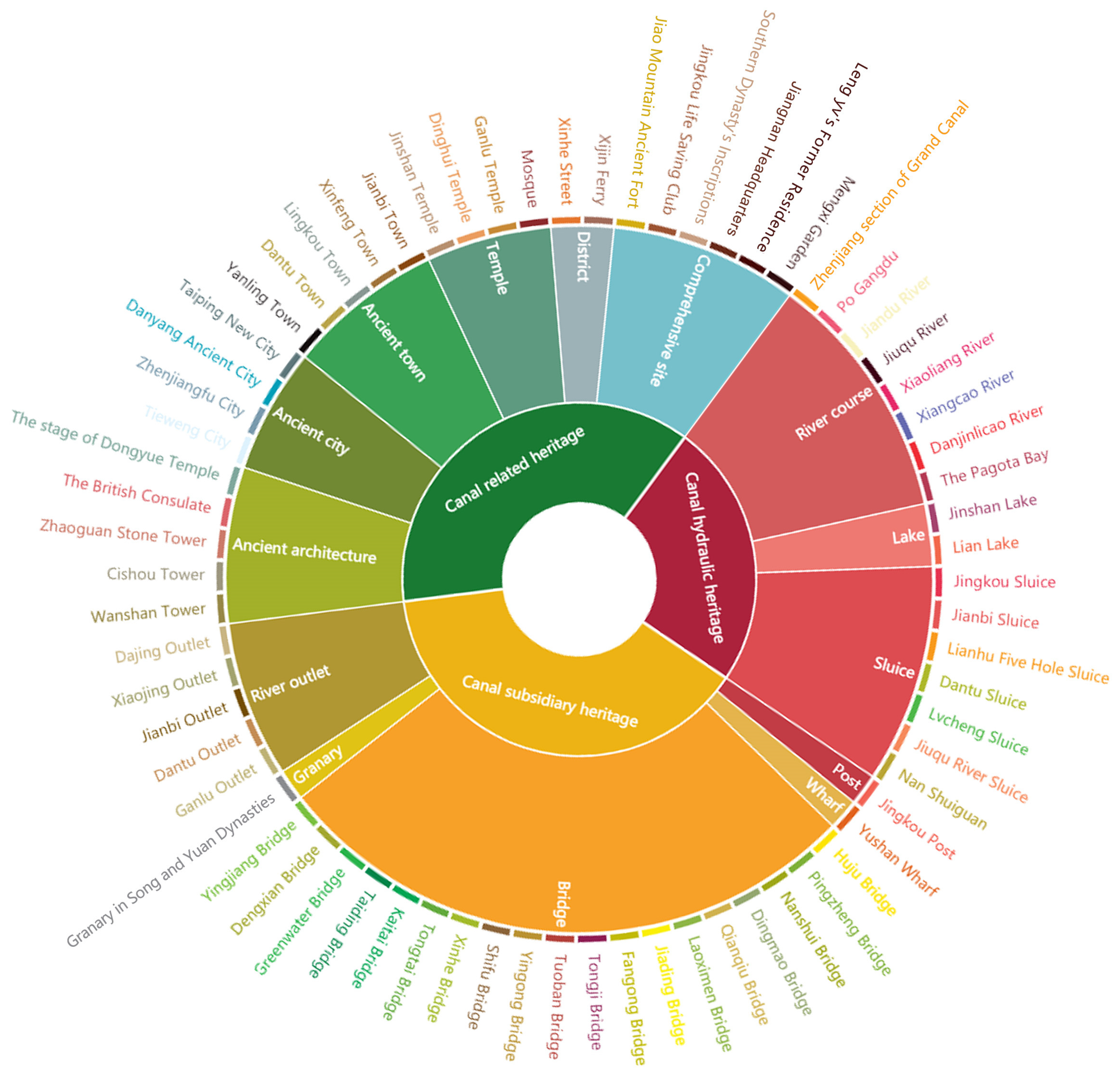
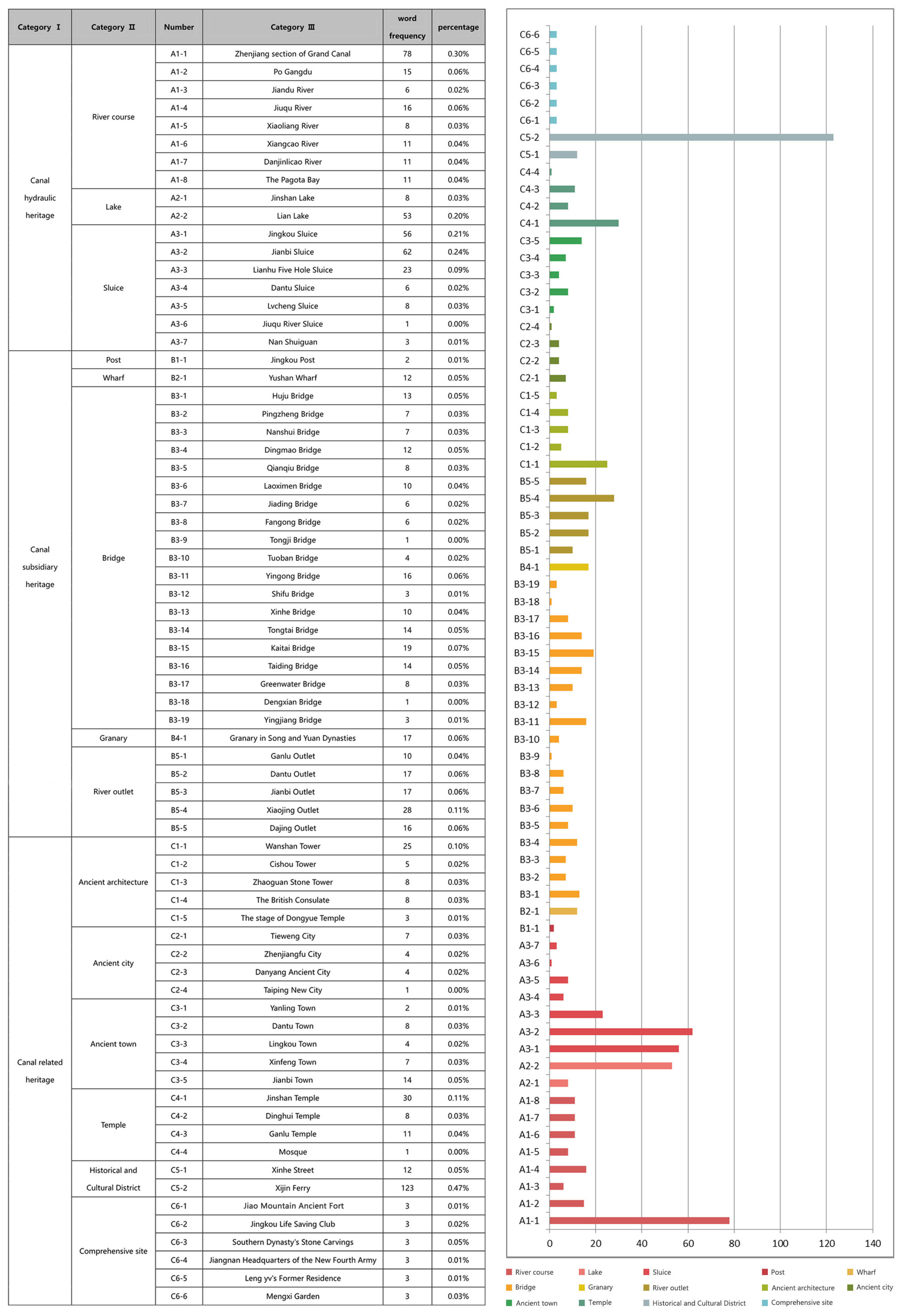
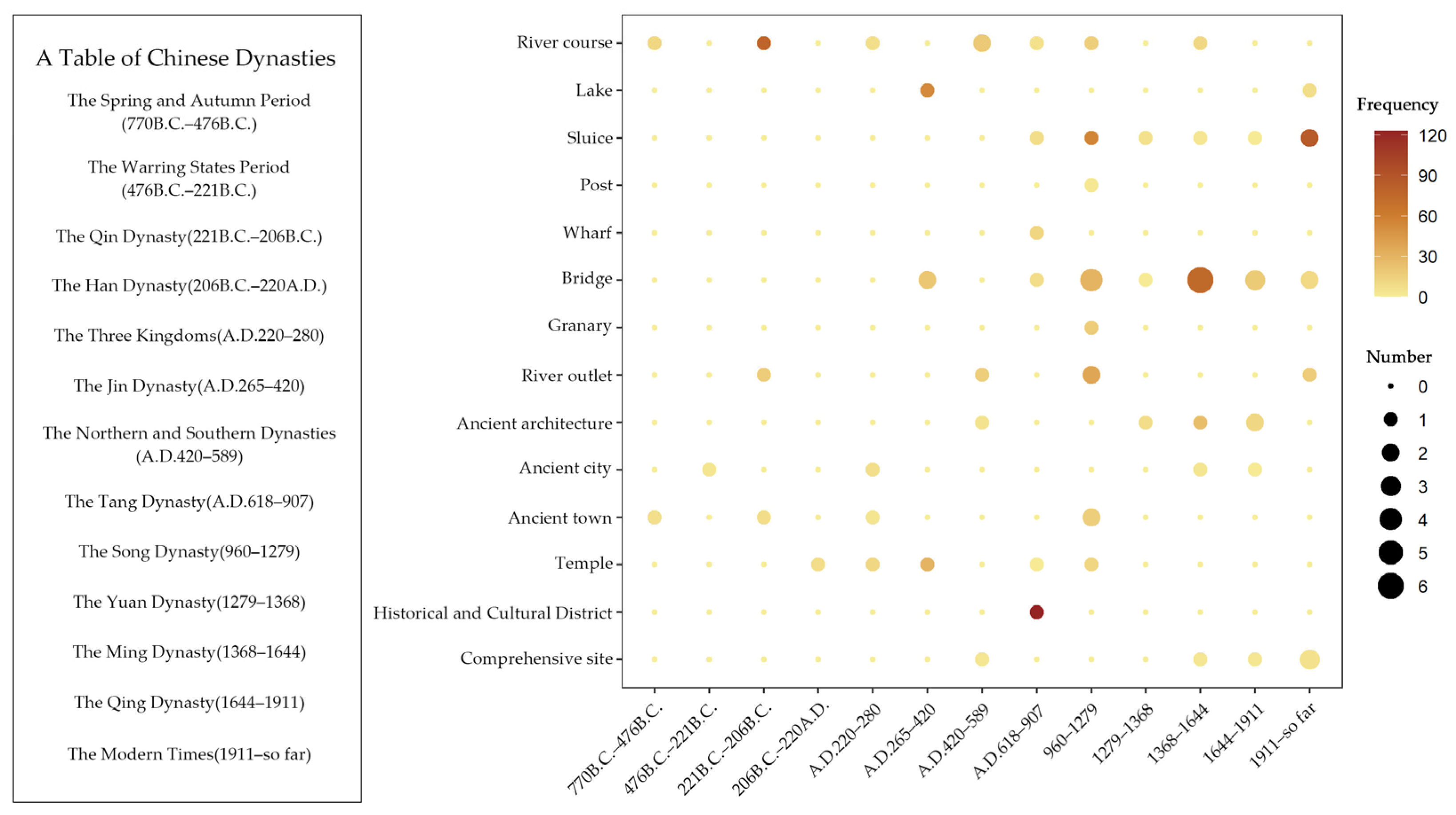
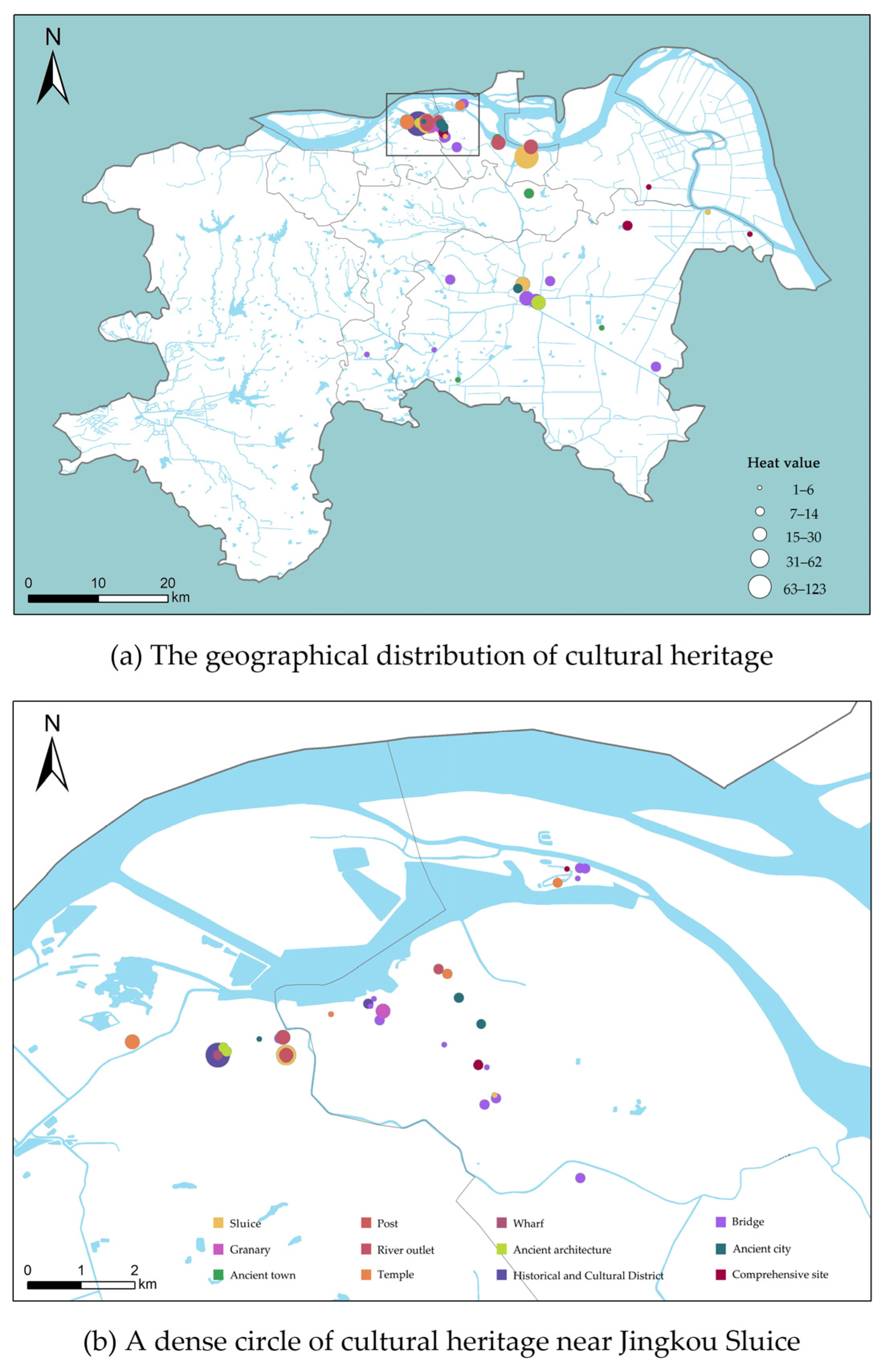
| WOAs | Number of Articles 1 | Reading Times in Total 2 | Recommended Times in Total 2 |
|---|---|---|---|
| Canal Network | 8 | 1690 | 35 |
| Zhenjiang Style | 5 | 18,555 | 435 |
| Danyang Daily | 4 | 30,871 | 261 |
| Zhenjiang Release | 2 | 4024 | 31 |
| Jingjiang Evening News | 2 | 843 | 7 |
| No. | Feature Words | Frequency | No. | Feature Words | Frequency |
|---|---|---|---|---|---|
| 1 | Zhenjiang | 841 | 26 | Sunan Canal | 59 |
| 2 | The Grand Canal | 809 | 27 | Ship | 56 |
| 3 | Danyang 1 | 299 | 28 | Jingkou Sluice | 56 |
| 4 | Culture | 243 | 29 | Zhenjiang section | 54 |
| 5 | History | 221 | 30 | Confluence of Grand Canal and Qiantang River | 53 |
| 6 | The Yangtze River | 166 | 31 | Lian Lake | 53 |
| 7 | The ancient canal | 157 | 32 | Ecology | 48 |
| 8 | Develop | 128 | 33 | Water conservancy | 46 |
| 9 | Xijin Ferry | 123 | 34 | Yangzhou | 46 |
| 10 | Jiangnan Canal | 116 | 35 | Channel | 45 |
| 11 | Beijing-Hangzhou Grand Canal | 105 | 36 | Jiangsu | 44 |
| 12 | Jiangnan | 97 | 37 | Stone Carving | 42 |
| 13 | Jianbi | 88 | 38 | Water transport | 41 |
| 14 | Protect | 85 | 39 | Yunyang | 41 |
| 15 | Jingkou | 83 | 40 | Shipping | 40 |
| 16 | Grand Canal cultural belt | 81 | 41 | Tuyang Canal | 40 |
| 17 | Ruins | 79 | 42 | Bridge | 39 |
| 18 | Zhenjiang section of the Grand Canal | 78 | 43 | Jiaoshan | 39 |
| 19 | River course | 68 | 44 | Jinshan | 38 |
| 20 | North and south | 64 | 45 | Wharf | 38 |
| 21 | Water transport | 63 | 46 | Cultural relics protection | 38 |
| 22 | Jianbi Sluice | 62 | 47 | Runzhou | 37 |
| 23 | River outlet | 62 | 48 | Tang dynasty | 37 |
| 24 | Excavate | 61 | 49 | Grain | 36 |
| 25 | Inherit | 60 | 50 | Booming | 36 |
| Category | High-Frequency Words (Top 20) | Frequency |
|---|---|---|
| Shipping traffic | river course/cao yun/river mouth/ship/water conservancy/channel/water transport/shipping/wharf/grain/ferry/customs/navigation lock/hub/channel segment/waterway/canal/business/port/estuary | 693 |
| Historical figure | Qin Shihuang/Qianlong/Sun Quan/Sui Yangdi/Pearl Buck/Han Shizhong/King Wu/Liu Yu/Kangxi/Li Po/Lv Meng/farmer/Guangxu/Emperor Wen/minister/Daoguang/Fan Zhongyan/Liang Wudi/Liu Bei/Lu You | 221 |
| Natural environment | ecology/scenery/landscape/rivers/environment/river water/lake water/scene/ surface of a river/landscape belt/beautiful scenery/lake/lake surface/season/ afforest/bright moon/green brick/spring breeze/grey tile/early morning | 211 |
| Architectural relic | bridge/wall/ancient city/ancient street/block/stage/pagoda/street/sculpture/ancient bridge/stone beast/remains/ruins/mausoleum/restaurant/town/former home/ pavilion/temple/city gate | 210 |
| Cultural product | cultural relic/diet/program/taste/aromatic vinegar/Yao Meat/delicious food/pot noodles/famous dishes/silk/specialty/dialect/large meatball/flavor/skill/noodle/ make wine/polished glutinous rice/exorcise evil spirits/silk weaving | 135 |
| Military warfare | military/army/war/concession/liberate/station troops/First Opium War/Zhenjiang Army/Beifu Army/army provisions/anti-gold general/Japanese troops/officers and men/Taiping Army/treaty/war disorder/occupy/station/aggressor/headquarters | 128 |
| Literature and art | poet/Dream Brook Sketchbook/regular script/verse/stone carving/Legend of the White Snake/horizontal inscribed board/famous phrases/famous works/poetry/men of letters/couplet/inscription/calligrapher/picture scroll/mural/Literary giant/litterateur/Song of Inspector Ding/the ancestor of big characters | 110 |
Publisher’s Note: MDPI stays neutral with regard to jurisdictional claims in published maps and institutional affiliations. |
© 2022 by the authors. Licensee MDPI, Basel, Switzerland. This article is an open access article distributed under the terms and conditions of the Creative Commons Attribution (CC BY) license (https://creativecommons.org/licenses/by/4.0/).
Share and Cite
Yang, Y.; Sha, C.; Su, W.; Donkor, E.K.N. Research on Online Destination Image of Zhenjiang Section of the Grand Canal Based on Network Content Analysis. Sustainability 2022, 14, 2731. https://doi.org/10.3390/su14052731
Yang Y, Sha C, Su W, Donkor EKN. Research on Online Destination Image of Zhenjiang Section of the Grand Canal Based on Network Content Analysis. Sustainability. 2022; 14(5):2731. https://doi.org/10.3390/su14052731
Chicago/Turabian StyleYang, Yan, Chunfa Sha, Wencheng Su, and Edwin Kofi Nyefrer Donkor. 2022. "Research on Online Destination Image of Zhenjiang Section of the Grand Canal Based on Network Content Analysis" Sustainability 14, no. 5: 2731. https://doi.org/10.3390/su14052731
APA StyleYang, Y., Sha, C., Su, W., & Donkor, E. K. N. (2022). Research on Online Destination Image of Zhenjiang Section of the Grand Canal Based on Network Content Analysis. Sustainability, 14(5), 2731. https://doi.org/10.3390/su14052731







